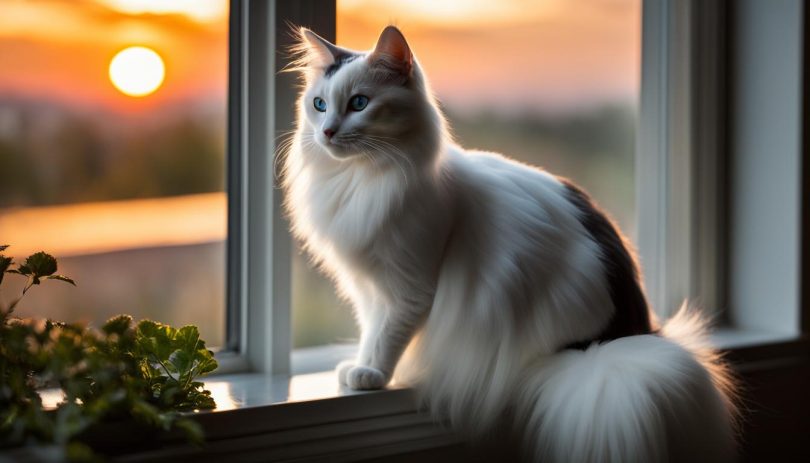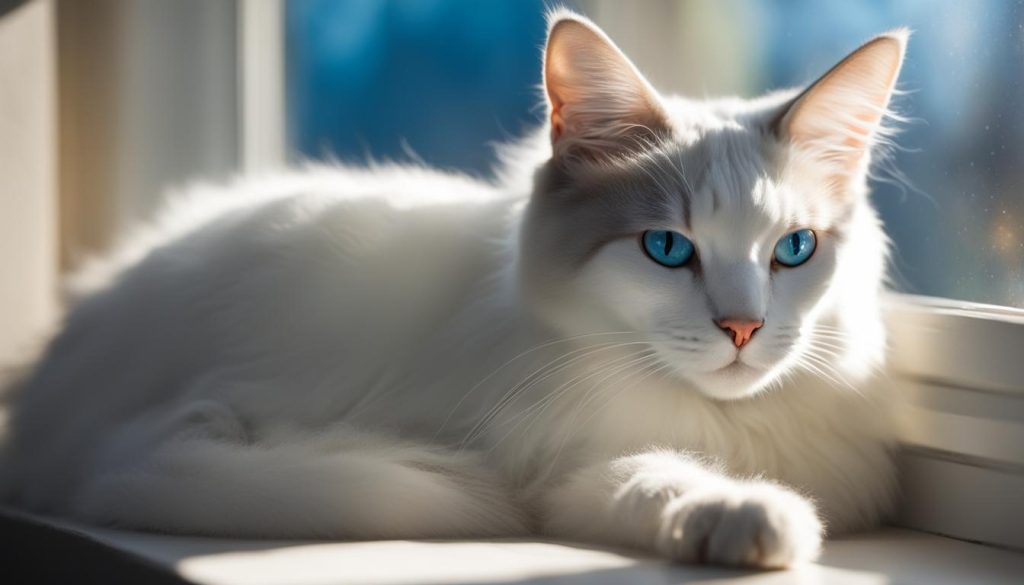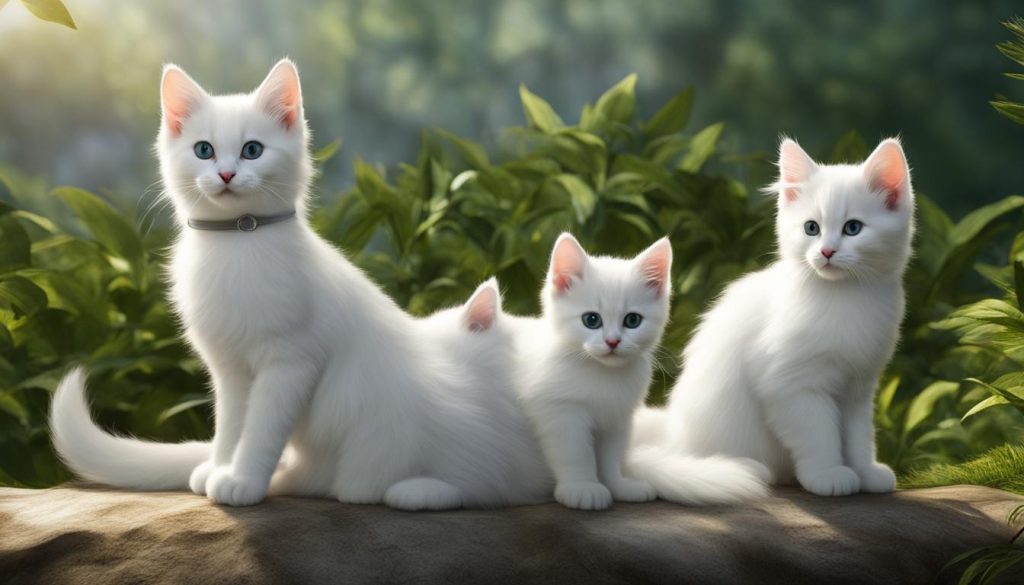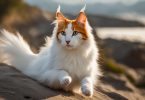Welcome! Join me on a fascinating journey into the world of Turkish Van Cats with their mesmerizing grey and white coat patterns. These unique felines have captivated cat enthusiasts around the globe, and in this article, we will uncover the secrets behind their origins, their distinct appearance, and much more.
Key Takeaways:
- Turkish Van Cats have a stunning grey and white coat pattern.
- They possess a rich history, with origins dating back to southeast Turkey.
- The breed has unique characteristics, including a soft cashmere-like coat and a distinctive brush-like tail.
- Turkish Van Cats are known for their love of water and fascinating genetic legacy.
- While finding a purebred Turkish Van may be rare, lookalikes can still make wonderful companions.
Turkish Van Cats: Breed History
The Turkish Van Cats have a rich and intriguing history that dates back to southeast Turkey and beyond. The origins of the breed are shrouded in mystery, with some speculating that they may have been brought to Europe by Crusaders. The breed was officially recognized by the UK-based Governing Council of the Cat Fancy in 1969 and gained recognition in the United States by the Cat Fanciers’ Association in 1994.
From Turkey to the World
The Turkish Van Cats, also known as Van Cats, have a fascinating journey that spans centuries. It is believed that these distinctive felines originated in the Van region of Turkey, where they were highly valued for their hunting abilities and unique coat pattern. Over time, these cats ventured beyond Turkey, capturing the hearts of cat lovers around the world.
A Breed of Mystery and Elegance
With their striking appearance and captivating history, Turkish Van Cats have become a breed known for their mystery and elegance. Their semi-longhaired coats, adorned with a combination of white and colored patches, make them truly stand out. These cats are not only visually stunning but also possess a curious and adventurous nature. They are known to be athletic, agile, and highly intelligent, making them excellent companions for those who appreciate an active and engaging pet.
Turkish Van Cats: Breed Description
Turkish Van Cats are truly stunning with their unique grey and white coat pattern. They have a glistening chalk-white body that is accented by color patches limited to the tail and head. The contrast between the white and the grey is visually striking and adds to their overall elegance.
Aside from their beautiful coat, Turkish Van Cats have a sturdy and graceful body structure. They are known for their strong muscles and athletic abilities, allowing them to jump and climb with ease. Their tail is another distinguishing feature, with a luxurious brush appearance that adds to their charm.
One of the most captivating aspects of Turkish Van Cats is their eye color. Their eyes can be amber, blue, or a striking combination of both. This adds an element of mystery and allure to their overall appearance. Their eyes, combined with their unique coat pattern, make them truly mesmerizing.
The Graceful Beauty of Turkish Van Cats
“The Turkish Van Cats have an exquisite beauty that sets them apart. Their grey and white coat, combined with their striking eye colors, make them a breed that captures attention and hearts.” – Cat Enthusiast
Whether they are playing, lounging, or gracefully exploring their surroundings, Turkish Van Cats exude an air of elegance and poise. Their unique appearance and distinct personality make them a breed that is adored by many.
Now that we have explored the captivating breed description of Turkish Van Cats, let’s dive into some fascinating facts that make them even more intriguing.
5 Fascinating Facts about Turkish Van Cats
If you’re intrigued by the charm and beauty of Turkish Van Cats, you’ll be fascinated to learn some intriguing facts about this unique breed. From their distinctive coat pattern to their love of water, Turkish Van Cats have captivating characteristics that set them apart. Let’s explore five fascinating facts about Turkish Van Cats.
The Piebald Gene
Turkish Van Cats have a mesmerizing coat pattern known as piebald. This pattern is created by a specific gene that causes patches of solid color on a predominantly white coat. The result is their striking gray and white appearance. The piebald gene is also found in other cat breeds, such as the Maine Coon and the British Shorthair.
A Love for Water
Unlike many other cat breeds, Turkish Van Cats have a fondness for water. They enjoy playing in water bowls, dipping their paws into the faucet, and even swimming. This unique trait is believed to have originated from their ancestors’ need to swim in the Lake Van region of Turkey to cool off during hot summers.
Genetic Legacy
The Turkish Van Cat’s genetic legacy can be traced back beyond its native land. Some theories suggest that the breed may have been brought to Europe by Crusaders, adding to its mysterious origins. The recognition of the Turkish Van breed by prestigious cat associations has solidified its place among the feline elite.
A Rare Treasure
Turkish Van Cats are considered rare treasures in the world of cat breeds. Their unique appearance and captivating personality make them highly sought-after among cat enthusiasts. If you’re lucky enough to have a Turkish Van Cat in your life, you’ll have a one-of-a-kind companion who will capture your heart with its beauty and charm.
| Turkish Van Cats: 5 Fascinating Facts |
|---|
| Fact 1: The Piebald Gene |
| Turkish Van Cats have a mesmerizing coat pattern known as piebald, created by a specific gene that causes patches of solid color on a predominantly white coat. |
| Fact 2: A Love for Water |
| Turkish Van Cats have a unique fondness for water and enjoy playing in water bowls, dipping their paws in faucets, and even swimming. |
| Fact 3: Genetic Legacy |
| The Turkish Van Cat’s genetic legacy can be traced back to the Crusaders, adding to its mysterious origins. |
| Fact 4: A Rare Treasure |
| Turkish Van Cats are considered rare treasures, highly sought-after among cat enthusiasts due to their unique appearance and captivating personality. |
These five fascinating facts showcase the allure and mystique of Turkish Van Cats. Whether it’s their striking coat pattern, their affinity for water, or their intriguing genetic legacy, Turkish Van Cats are an extraordinary breed that continues to captivate us with their beauty and charm.
Is My Cat a Turkish Van?
If you have a cat with a grey and white coat pattern, you may wonder if it is a Turkish Van. While many cats may resemble Turkish Vans, it is important to understand that finding a purebred Turkish Van is rare. However, these lookalikes can still make wonderful companions and possess their own unique charm.
To determine if your cat is a Turkish Van, there are a few key characteristics to look for. Turkish Van Cats have a glistening chalk-white body with color patches limited to the tail and head. Their coat texture is soft and cashmere-like, and their tail has a distinctive brush appearance. Additionally, Turkish Van Cats have a sturdy and graceful body structure and captivating eye colors, which can be either amber, blue, or a combination of both.
While your cat may share some similarities with a Turkish Van, it is important to remember that coat pattern alone is not enough to determine its breed. If you are curious about your cat’s heritage, you can consider DNA testing to uncover its genetic background. Regardless of their breed, all cats are unique and special in their own way, bringing joy and companionship to our lives.
A Closer Look at Turkish Van Cats & Their Fascinating Facts
Turkish Van Cats are truly mesmerizing creatures with their unique grey and white coat pattern. They have captivated the hearts of many cat enthusiasts, and it’s easy to see why. With their charming appearance and distinctive characteristics, Turkish Van Cats stand out among other breeds.
The Turkish Van’s coat is a stunning combination of chalk-white and color patches limited to the head and tail. This striking contrast adds to their allure and makes them a sight to behold. Their coat texture is soft and cashmere-like, and their tails have a brush-like appearance, adding elegance to their overall look.
One of the most fascinating facts about Turkish Van Cats is their love for water. Unlike many other feline counterparts, these cats enjoy swimming and playing in water. This unique trait has led some to believe that Turkish Van Cats may have evolved from a breed of cats that lived near bodies of water.
| Fascinating Facts about Turkish Van Cats | |
|---|---|
| Fact 1: | Turkish Van Cats have a rare piebald gene, which is responsible for their unique coat pattern. |
| Fact 2: | They are known for their love of water and swimming. |
| Fact 3: | Turkish Van Cats have captivated the hearts of cat enthusiasts worldwide with their enchanting appearance. |
| Fact 4: | They have a mesmerizing eye color palette, which can be amber, blue, or a combination of both. |
With their striking appearance and unique traits, Turkish Van Cats bring a sense of joy and wonder into the lives of their owners. They are truly a breed that stands out and leaves a lasting impression. Whether it’s their mesmerizing coat pattern or their love for water, Turkish Van Cats continue to fascinate and charm all who encounter them.
References:
- The International Cat Association. (n.d.). Turkish Van. Retrieved from https://www.tica.org/breeds/browse-all-breeds?view=article&id=1111:turkish-van-introduction&catid=79
- Cat Fanciers’ Association. (n.d.). The Turkish Van. Retrieved from https://cfa.org/turkish-van/
The Wonderful World of Grey and White Cat Breeds
Grey and white cats are known for their stunning coat combinations, which make them popular among cat enthusiasts. These feline beauties come in various breeds, each with its own distinct characteristics and personality traits. Let’s take a closer look at some of the fascinating grey and white cat breeds:
Russian Blue
The Russian Blue is a regal and elegant breed with a short, dense coat of bluish-gray fur. Known for their striking green eyes and gentle demeanor, Russian Blues are intelligent and affectionate companions.
British Shorthair
The British Shorthair is a robust breed with a plush, dense coat. Their round faces and copper or gold eyes give them a sweet and teddy bear-like appearance. Known for their independent and easygoing nature, British Shorthairs make great family pets.
Maine Coon
The Maine Coon is a large and majestic breed with a thick, semi-longhaired coat. Their tufted ears and bushy tails add to their striking appearance. Maine Coons are known for their friendly and sociable nature, making them great companions.
Birman
The Birman, also known as the “Sacred Cat of Burma,” has a silky, medium-length coat in various colors, including gray and white. Their striking blue eyes and color-point patterns make them visually captivating. Birmans are known for their gentle and affectionate nature, making them wonderful companions.
These are just a few examples of the grey and white cat breeds that showcase the beauty and charm of these unique felines. Whether you’re drawn to the regal elegance of the Russian Blue, the teddy bear-like sweetness of the British Shorthair, the majestic presence of the Maine Coon, or the captivating allure of the Birman, there’s a grey and white cat breed to suit every preference and personality.
Table: Turkish Van Cat Adoption Resources in San Francisco, California
| Rescue Organization | Contact Information |
|---|---|
| San Francisco SPCA | www.sfspca.org |
| KitTea Cat Lounge | www.kitteasf.com |
| Wonder Cat Rescue | www.wondercatrescue.org |
Turkish Van Kittens and Adults Available for Adoption
If you’re looking to add a Turkish Van cat to your family, you’ll be pleased to know that both kittens and adult cats of this breed are sometimes available for adoption. While availability may vary, it’s worth checking local shelters and rescue organizations to see if any Turkish Van cats are in need of a loving home.
When adopting a Turkish Van kitten, you have the opportunity to watch them grow and develop into their unique and beautiful adult selves. Kittens are full of energy and curiosity, providing endless entertainment and opportunities for bonding. Adopting a Turkish Van kitten can be a rewarding experience as you guide them through their early stages of life.
On the other hand, adopting an adult Turkish Van cat has its own advantages. Adult cats have already grown into their distinctive appearance and personality. They may be more settled and independent, making them a great choice for those who prefer a cat that is less demanding of constant attention. Additionally, adopting an adult cat gives you the chance to provide a loving home to a cat who may have had a difficult past.
Whether you choose to adopt a Turkish Van kitten or an adult cat, you’ll be opening your home to a loving and unique companion. Turkish Van cats are known for their friendly and affectionate nature, making them wonderful additions to any household.
Pros of Adopting a Turkish Van KittenPros of Adopting an Adult Turkish Van Cat
|
|
How to Recognize a Turkish Van Lookalike
When it comes to recognizing a Turkish Van lookalike, it can be quite challenging, as many cats can have a similar grey and white coat pattern. However, there are some key features and characteristics that can help you differentiate a true Turkish Van from other cats.
Distinctive Coat Pattern
One of the most defining features of a Turkish Van cat is its unique coat pattern. True Turkish Vans have a glistening chalk-white body with color patches limited to the tail and head. This distinctive coat pattern sets them apart from other grey and white cats.
Breed Characteristics
In addition to their coat pattern, Turkish Van cats have specific breed characteristics that can help identify them. They have a sturdy and graceful body structure and captivating eye colors, which can be either amber, blue, or a combination of both. These features contribute to the overall elegance and charm of the breed.
Seeking Professional Opinion
If you are unsure whether your cat is a Turkish Van or a lookalike, it may be helpful to seek the opinion of a professional. Veterinarians or breed experts can provide valuable insights and evaluate the physical traits and characteristics of your cat to determine its breed.
| Features | Turkish Van Cats | Lookalikes |
|---|---|---|
| Coat Pattern | Distinctive grey and white pattern limited to tail and head | Variable coat patterns, not limited to specific body areas |
| Eye Color | Amber, blue, or a combination of both | Varies, not specific to a breed |
| Body Structure | Sturdy and graceful | Varies, not specific to a breed |
By understanding the defining features of a true Turkish Van and seeking professional opinions when necessary, you can better differentiate a Turkish Van lookalike from other cats. Whether your cat is a true Turkish Van or a lookalike, they can still bring joy and companionship into your life.
Conclusion
After exploring the captivating world of Turkish Van Cats, it’s clear that their stunning grey and white coat pattern sets them apart. These elegant felines exhibit a unique charm that is hard to resist. Not only are they visually striking, but they also have a rich history and fascinating characteristics.
From their mysterious origins to their soft and cashmere-like coat texture, Turkish Van Cats continue to captivate cat enthusiasts around the world. Their distinctive brush-like tail and captivating eye colors add to their allure. Whether their eyes are amber, blue, or a combination of both, these felines are sure to steal your heart.
While finding a purebred Turkish Van may be rare, there are many lookalikes out there that can still bring joy and companionship. Cats with a similar grey and white coat pattern may possess their own unique charm and make wonderful additions to any home.
So whether you decide to adopt a Turkish Van, explore other grey and white cat breeds, or simply appreciate their beauty from afar, the world of grey and white felines offers a diverse range of fascinating companions. These cats are a true testament to the elegance and allure that can be found in the world of our feline friends.
FAQ
What is the history of Turkish Van Cats?
The origins of Turkish Van Cats are shrouded in mystery, but they are believed to have roots in southeast Turkey and may have been brought to Europe by Crusaders. The breed was officially recognized in the UK in 1969 and gained recognition in the United States in 1994.
What is the appearance of Turkish Van Cats?
Turkish Van Cats have a glistening chalk-white body with color patches limited to the tail and head. They have a soft and cashmere-like coat texture, a distinctive brush-like tail, and captivating eye colors which can be amber, blue, or a combination of both.
What are some fascinating facts about Turkish Van Cats?
Turkish Van Cats have a unique piebald gene that gives them their unique coat pattern. They also have a genetic legacy that can be found in other cat breeds with the “Van” pattern. Additionally, they are known for their love of water.
How do I know if my cat is a Turkish Van?
While finding a purebred Turkish Van can be rare, understanding the defining features of a true Turkish Van, such as their unique coat pattern and specific breed characteristics, can help differentiate them from other cats.
What are some other grey and white cat breeds?
There are several grey and white cat breeds, including the Russian Blue, British Shorthair, Maine Coon, and more, each with their own distinct characteristics and personality traits.
Where can I adopt a Turkish Van cat in San Francisco, California?
Websites like Adopt a Pet can connect you with Turkish Van cats available for adoption in your local area. Additionally, Turkish Van kittens and adults may sometimes be available for adoption from shelters and rescue organizations.
How can I recognize a Turkish Van lookalike?
Recognizing a Turkish Van lookalike can be challenging, as many cats can have similar coat patterns. However, understanding the defining features of a true Turkish Van, such as their unique coat pattern and specific breed characteristics, can help differentiate them from other cats.









